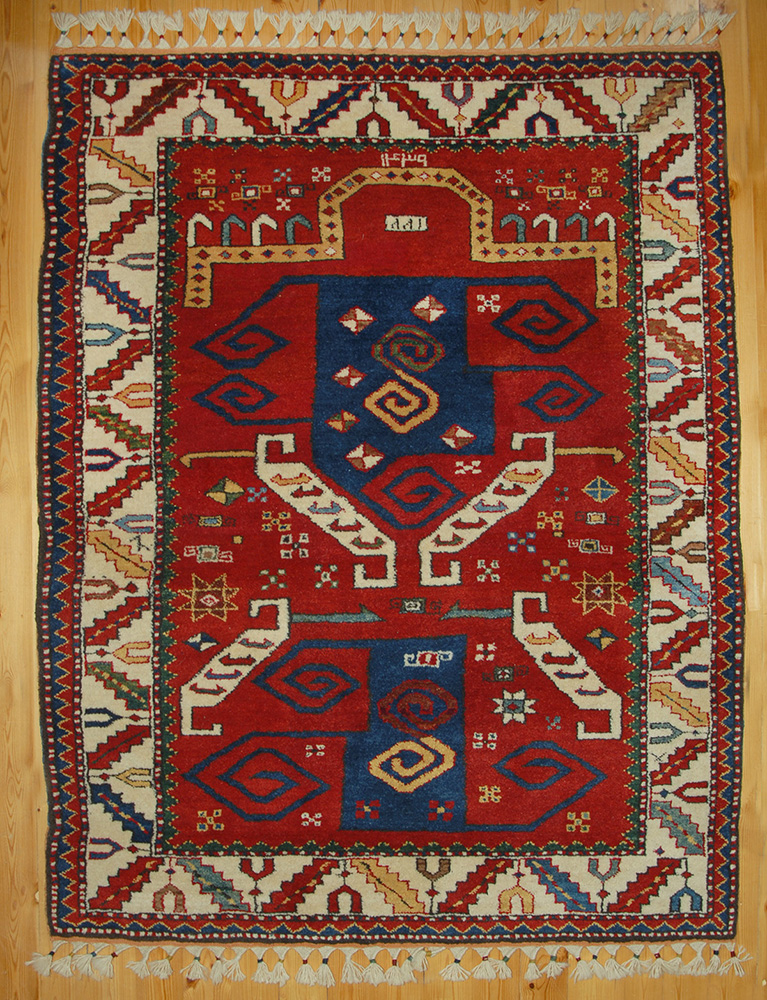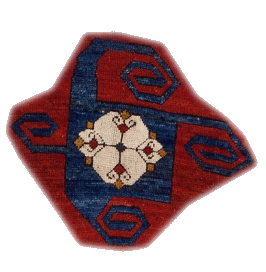

|
Kazak Pinwheel / Swastika rug CODE: KZPW12 Size (metric): 129x167cm Size (ft): 4'2"x5'5" Area: 2.15 m2 Density: 110 000 knots per square meter, totally ~ 230 000 knots Pile height: 0.7 cm End finish: triangular braided fringes Weaving period: 3 months Colors: red, mauve/old purple, yellow, cerulean blue, green, royal blue, maroon, aubergine, ivory, dark brown, light brown. Dyes: madder, weld (Reseda Luteola), onion skins, indigo, pomegranate skins, walnut husks, natural dark brown sheep wool, natural ivory sheep wool, natural medium brown sheep wool. Materials: Handcarded and handspun wool for pile, ivory wool warps and red wool wefts (two shots, dyed with onion skins and madder). 1cm of flatwoven kilim ends at both sides. - wool on wool Knots: Gördes (Turkish, symmetrical) Ends: five rows of decorative knotted meshwork Inscriptions: 1439 (=2018 weaving date), tamgas (tribal seal) of Afshar tribe Weaver: Sevda Handwoven in Azerbaijan |
||||||||||
|
Design: The design is distinguished by the typical
"Pinwheel" or Swastika shaped archaic devices located in the central
field. The swastika is an ancient symbol, often interpreted with celestial
connotations. According to some researchers, it represents the heavens
with the center of the swastika as the north star and the twisting arms of the motif symbolizing the
movement of the constellations around that focal point. It is graphically
portrayed in many weavings from Caucasian Azerbaijan, including the
Bordjalou and Kazak areas. This element is called "Dörd-buynuz" (means
"four rams") or "Damga" (Tamga) in Kazak region. Another theory sees swastika as a highly stylized zoomorphic motif. The element was widely used in early Turkish rugs and in some Central Asian weavings.
pic1. different type of pinwheel/swastika motives |
||||||||||
|
A 2600 years old cup found in Hasanlu Tepe (an archeological site of an
ancient city located in West Azerbaijan Province, a short distance south
of Lake Urmia) depicts a similar swastika motif.
The main
border shows a so called 'calyx and
leaf' motif and it contains two versions of Afshar tribal tamga.
|
||||||||||
Contact us for more information about this rug
.jpg)
.jpg)
.jpg)
.jpg)
.jpg)
.jpg)
.jpg)
.jpg)

Contact us for more information about this rug

|
For more information about the above rug or to place an order please email
vd@azerbaijanrugs.com |